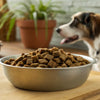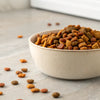Is Wet Dog Food More Expensive Than Dry? Understanding the Cost Dynamics of Dog Nutrition
- Houndsy
Table of Contents
- Introduction
- The Complex Economics Behind Wet Dog Food Pricing
- The Nutritional and Health Benefits of Wet Food: Is It Worth the Price?
- The Drawbacks of Wet Dog Food: Convenience, Waste, and Cost
- Finding Balance: Mixing Wet and Dry Food & Feeding Strategies
- The Bigger Picture: Feeding Your Dog Well Without Sacrificing Your Budget or Lifestyle
- Conclusion
Introduction
Imagine this: you’re at the pet store, standing in front of shelves stocked full of dog food options. You pick up a can of wet dog food and notice the price tag—it’s significantly higher than that of dry kibble. The question arises: is wet dog food more expensive than dry? As pet owners, we often grapple with the costs associated with providing the best nutrition for our furry friends, especially as pet food prices have surged by more than 14% in recent years. This post will delve into the underlying factors contributing to the price differences between wet and dry dog food, the benefits and drawbacks of each, and how we can optimize our feeding routines without breaking the bank.
Throughout this article, we’ll explore the economics of wet dog food pricing, the nutritional advantages it offers, the potential downsides, and practical strategies to navigate costs effectively. By the end, you’ll have a comprehensive understanding of whether the higher price of wet dog food is justified and how to make informed choices for your pet's diet. So, let’s reflect on our own preferences and practices—are we maximizing the benefits of our dog’s feeding experience while managing costs efficiently?
The Complex Economics Behind Wet Dog Food Pricing
To answer the question of whether wet dog food is more expensive than dry, we need to explore several key factors that contribute to its pricing structure.
High-Quality Ingredients Drive Costs
One of the primary reasons for the higher cost of wet dog food is the quality of ingredients used. Wet dog food often contains higher meat content compared to dry kibble, which can include fillers such as corn, wheat, or soy. Premium wet foods are formulated with fresh or minimally processed meats, organ meats, and wholesome vegetables, all of which come at a higher price point due to their nutritional value and sourcing.
Manufacturing and Packaging Expenses
Wet dog food also incurs higher manufacturing and packaging costs. Each can or pouch must be sealed individually to maintain moisture and freshness, necessitating more intricate and costly packaging than the bulk bags typically used for dry food. The production process for wet food is more resource-intensive, contributing to the overall price increase at the retailer level.
Supply Chain Challenges and Market Dynamics
The pet food industry is influenced by a variety of external factors, including supply chain disruptions and market dynamics. Events such as the COVID-19 pandemic have led to closures at meatpacking plants, resulting in shortages and increased prices for raw materials. Furthermore, the pet food market is dominated by a few large companies, which can impact pricing strategies across various dog food brands.
Summary
In summary, the combination of premium ingredients, sophisticated manufacturing processes, and supply chain challenges all contribute to the higher prices of wet dog food on store shelves. Understanding these factors helps pet owners make informed choices that align with their budgets and their pets' nutritional needs.
The Nutritional and Health Benefits of Wet Food: Is It Worth the Price?
While the cost of wet dog food is higher, it’s essential to evaluate the potential health benefits it may offer, which can justify the investment.
Hydration and Moisture Content
Wet dog food contains about 70-80% moisture, making it an excellent source of hydration for dogs that may not drink enough water on their own. This is particularly beneficial for older dogs or those with specific health conditions, such as urinary or kidney diseases. By incorporating wet food into their diet, we can help ensure our pets stay properly hydrated, especially during hot weather.
Palatability and Appetite Stimulation
The aroma and texture of wet dog food closely resemble fresh meat, making it more appealing to dogs, especially those that are picky eaters or recovering from illness. The palatability of wet food can encourage consistent nutrition, which is crucial for maintaining our dogs’ health.
Balanced Nutrition
High-quality wet dog foods are formulated to provide balanced nutrition, often retaining important nutrients that may degrade during the processing of dry foods. When we choose premium wet food, we can feel confident that it meets our dogs' dietary needs.
Summary
While wet dog food may be more expensive, its benefits regarding hydration, palatability, and nutrition can make it a worthwhile investment in our pets’ health. However, it’s essential to choose wisely and consult our veterinarians to ensure we are selecting the right products.
The Drawbacks of Wet Dog Food: Convenience, Waste, and Cost
Despite the advantages of wet dog food, it’s important to consider the drawbacks that come with it, particularly in terms of convenience and cost.
Convenience and Messiness
Wet dog food can be messier to handle compared to dry kibble. For pet owners with multiple dogs or larger breeds, the cleanup can become burdensome. Leftover food must be refrigerated and consumed within a short timeframe to avoid spoilage, contrasting with the convenience of dry kibble, which can be left out all day without risk of spoiling.
Waste and Environmental Concerns
The environmental impact of wet dog food packaging is another consideration. Each can or pouch generates waste, contributing to landfill concerns. In contrast, a single large bag of dry food generates much less packaging waste.
Higher Cost Per Calorie
When we break down the costs, wet dog food can be significantly more expensive per calorie compared to dry food. Feeding a 50-pound dog exclusively wet food can lead to monthly expenses that can stretch into the hundreds. This reality places a financial burden on pet owners, especially those on a budget.
Summary
While wet dog food offers several benefits, its messiness, increased waste, and higher cost per calorie can deter some pet owners from making it their primary feeding choice. Weighing these drawbacks against the benefits is essential for making informed decisions.
Finding Balance: Mixing Wet and Dry Food & Feeding Strategies
One effective strategy many pet owners adopt is mixing wet and dry dog food. This approach can allow us to enjoy the best of both worlds while managing costs.
Benefits of Mixing
Combining wet and dry food can enhance palatability, providing dogs with the flavor and moisture of wet food while benefitting from the cost-effectiveness and convenience of dry kibble. This method can also help maintain hydration while promoting dental health, as the dry kibble encourages chewing and reduces tartar buildup.
Portion Control and Smart Feeding Tools
To ensure that our pets receive the appropriate amount of nutrition without overfeeding, employing portion control tools is crucial. This is where innovative products like the Houndsy Kibble Dispenser come into play. Designed with ergonomic convenience and mid-century modern aesthetics, the Houndsy Kibble Dispenser allows us to serve perfect portions every time. With a large storage capacity and BPA-free liner, this dispenser simplifies the feeding process while reducing waste.
Exploring Feeding Methods
To further optimize feeding routines, consider the following strategies:
- Buy in Bulk: Purchasing larger cans or bulk quantities of dry food can reduce overall costs.
- Look for Sales and Discounts: Many retailers offer loyalty programs, coupons, or discounts that can help us save on pet food expenses.
- Consult Your Veterinarian: Always seek advice from your vet regarding dietary choices, especially if your dog has specific health needs or allergies.
Summary
By mixing wet and dry food and utilizing portion control tools like the Houndsy Kibble Dispenser, we can optimize our dogs’ feeding routine, ensuring they receive balanced nutrition without compromising our budget.
The Bigger Picture: Feeding Your Dog Well Without Sacrificing Your Budget or Lifestyle
Feeding our dogs well is not just about choosing the right food; it’s about creating a sustainable and enjoyable feeding experience.
Long-Term Considerations
While wet dog food may be pricier, it’s essential to consider long-term effects on our pet’s health. Investing in high-quality nutrition can lead to better health outcomes, potentially reducing veterinary costs down the line.
Building a Feeding Routine
Creating a consistent feeding routine that incorporates both wet and dry food can help our dogs thrive. Paying attention to their preferences and dietary needs allows us to adapt our feeding strategies as necessary.
Reflecting on Our Practices
As we reflect on our own feeding practices, consider the following questions: Are we maximizing the nutritional benefits of our choices? How can we adjust our routines to enhance our pets’ feeding experiences while managing costs effectively?
Conclusion
In conclusion, while wet dog food is generally more expensive than dry, its benefits in hydration, palatability, and nutritional value may justify the investment for many pet owners. By understanding the factors influencing pricing and being strategic in our feeding practices, we can ensure that our dogs receive the best possible nutrition without compromising our budgets.
We invite you to explore products like the Houndsy Kibble Dispenser to further enhance your feeding experience. Simplifying the feeding ritual can elevate the joy of caring for our pets while maintaining efficiency and style.
FAQ
1. Is wet dog food really better for my dog’s health than dry food?
Wet dog food often provides better hydration and is more palatable, which can be beneficial for picky eaters or dogs with certain health conditions. However, many high-quality dry foods also offer balanced nutrition.
2. Can I feed my dog only wet food without causing dental issues?
Feeding exclusively wet food may increase the risk of dental plaque, as it lacks the abrasive action of dry kibble. Regular dental care, including brushing and veterinary check-ups, is essential regardless of the diet.
3. How can I save money on expensive wet dog food?
Consider mixing wet and dry food, buying in bulk, looking for sales, and utilizing loyalty programs to save on costs.
4. Does higher price always mean better quality in wet dog food?
Not necessarily. While many premium brands offer high-quality ingredients, it’s essential to read labels and choose products that meet your dog's nutritional needs without unnecessary fillers.
5. What is the best way to store wet dog food once opened?
Once opened, wet dog food should be refrigerated and consumed within a few days to prevent spoilage. Store it in an airtight container for optimal freshness.
By considering these insights, we can make informed choices that optimize our dogs' nutrition while balancing convenience and cost.












